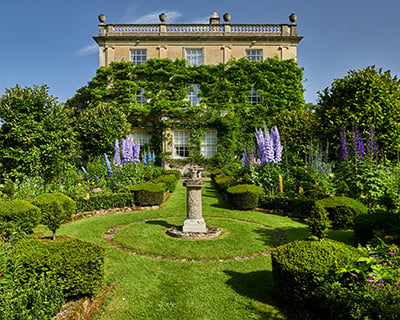Highgrove: The King’s crowning glory
King Charles III cares passionately about his garden at Highgrove. Here Liz Potter takes a look at his gardening ethos and green credentials
The horticultural leanings of the King are no secret. In a 2010 BBC TV documentary, Alan Titchmarsh described him as “the best royal gardener in history”, but in fact the King’s passion is not without precedent. In the 18th century, his great-great-great-great grandfather, King George III, took an active interest in the nation’s agricultural improvement, earning himself the epithet ‘Farmer George’.
The King adopted organic practices on his 353-acre Highgrove Estate in 1990. But his love of nurturing plants goes far deeper than the somewhat prosaic raising of crops, as evidenced by the atmospheric, well-considered garden he has created at Highgrove. “My interest in gardening was always there,” he told Alan Titchmarsh in 2010. “As a child my sister and I were given a little plot at Buckingham Palace at the back of the border for growing vegetables. But it’s not until you have somewhere of your own that it becomes more possible… The thing about [Highgrove] was that it was a blank canvas; I had to start from scratch.”
This world-famous 15-acre Gloucestershire garden attracts some 40,000 visitors a year. The layout comprises vistas and interlinked rooms, topiary and temples, fountains and sunny terraces flanked by yew hedges planted 43 years ago to protect his young family from the paparazzi. Head of Gardens Brian Corr leads the 11-strong gardening team, who affectionately refer to the King as ‘The Boss’. But just as his mother would pick up a shovel and plant a tree, so King Charles tours the garden with a pruning saw in hand. “I love evening patrol at the weekend,” he says. “As I potter about I notice things and weed or prune bits off. I’m sure most people come here and think I don’t do anything. But I do.” The King also enjoys a spot of hedge-laying. “It keeps you relatively sane. And it’s very good exercise.”
The garden was laid out in the early 1980s, with help from horticultural friends including the naturalist Miriam Rothschild, garden designer Rosemary Verey, and the former owner of Hatfield House, the Marchioness of Salisbury, herself a champion of
“The fun is to try things that aren’t normally done,” he says. “There are things that amuse me, which other people may think are eccentric. But then I think the fun is hearing people’s reactions. The different moods tell different stories as you go round. Features help – little buildings and things that catch the eye. That’s the joy. Little views – come round a corner and something draws you on.”
The King has an artist’s appreciation of light, colour and composition. “I see [my gardening] rather like painting a watercolour,” he says. “You want to lay on the colour; don’t be careful about it! I used to be frightfully careful when I started, but now the great thing is to slap it on.”
While the King appreciates the regimental majesty of delphiniums and elegant sufficiency of clipped topiary, he prefers a naturalistic look. “I hate all that over-manicured style of gardening – I like working with nature,” he says. “I’m always intrigued what people think it’s going to be like before they come. They all think it’s going to be manicured and formal. So when they come, they’re amazed.”
He loves the colourful abandon of the
Other planet-friendly initiatives include making
His green credentials are second to none, having delivered his first speech on environmental issues in 1970 at age 21. “Even in the 1960s when I was a teenager I hated what was going on – destroying and pulling up and tearing down all the wild places,” he says. “So many of these things had taken hundreds of years to grow. It takes forever to recreate lost habitat. We have to rediscover the absolute importance – critical now – of working in harmony with nature.”
The King stood firm in the face of criticism and mockery. “I had a lot of flack – but I knew what I was doing,” he says. “It was ‘potty this’ and ‘loony that’. I love the countryside and being in touch with things. I happily talk to the plants, the trees, and listen to them. I think it’s absolutely crucial.”
As the King and Queen Camilla move to Buckingham Palace for their formal royal duties in London, his heart will remain at Highgrove. Its important model for sustainable gardening will continue to inspire its thousands of visitors for decades to come. The-then Prince of Wales wrote in 2014 “my enduring hope is that those who visit the garden may find something to inspire, excite, fascinate or soothe them.”


